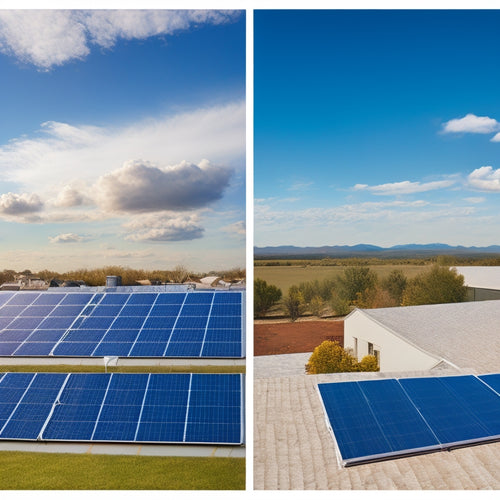
3 Tips for Easy Electric Vehicle Battery Swap
Share
You can guarantee a seamless electric vehicle battery swap by preparing thoroughly, streamlining the process, and choosing the right station. First, prepare by conducting a thorough vehicle inspection, cleaning battery terminals, and gathering necessary tools. Next, streamline the process by designating specific areas for tasks, implementing a standardized inspection checklist, and optimizing procedures. Finally, choose a station with high foot traffic, easy access to transportation routes, and compatible chargers. By following these tips, you'll be well on your way to a hassle-free battery swap - and there's more to explore to make the process even smoother.
Key Takeaways
• Ensure a clear and stable work surface with necessary tools within easy reach to minimize downtime and optimize the swap process.
• Conduct a thorough vehicle inspection, including electrical system and battery checks, to identify potential issues before the swap.
• Clean battery terminals and cables to prevent corrosion and ensure a smooth swap, and consider using a lift or hoist for efficient installation.
• Choose a convenient and accessible swap station with high foot traffic, easy access to transportation routes, and compatible chargers for your vehicle.
• Streamline the swap process by designating specific areas for tasks, implementing a standardized inspection checklist, and focusing on efficient layout design.
Preparing for the Battery Swap
Before starting the battery swap, make sure you have a clear, flat, and stable work surface, free from any obstacles or tripping hazards, and gather all necessary tools and equipment within easy reach. This will guarantee a smooth and safe process.
Begin by conducting a thorough vehicle inspection to identify any potential issues that may impact the battery swap. Check the vehicle's electrical system, brakes, and suspension to make sure they're functioning properly.
It's also essential to perform routine battery maintenance tasks, such as checking the battery's state of charge, electrolyte levels, and cell voltage. Make sure the battery is fully charged and in good condition to facilitate a seamless swap.
Take this opportunity to clean the battery terminals and cables to prevent corrosion and ensure a secure connection. By following these steps, you'll be well-prepared for a successful battery swap. Remember, a well-maintained vehicle and battery are vital for a hassle-free swap.
Streamlining the Swap Process
By having a fully charged and well-maintained battery, you've set the stage for a streamlined swap process, and now it's time to optimize the actual swap procedure. To achieve this, focus on implementing optimized procedures that minimize downtime and maximize efficiency. A well-designed layout is vital in facilitating a smooth swap process.
| Station Component | Optimized Procedure | Efficient Layout Tip |
|---|---|---|
| Battery Removal | Designate a specific area for battery removal to prevent mix-ups | Guarantee easy access to tools and personnel |
| Battery Inspection | Implement a standardized inspection checklist | Position inspection area near swap station |
| Battery Installation | Use a lift or hoist to simplify installation | Leave ample space for battery maneuvering |
Choosing the Right Station
When selecting a station for your electric vehicle battery swap, you'll typically want to prioritize locations with high foot traffic and easy access to major transportation routes. This guarantees a convenient and hassle-free experience. Consider stations situated near shopping centers, restaurants, or rest stops, as they tend to have ample parking and amenities.
Next, assess the station's charger type. Will it support your vehicle's charging requirements? Look for stations equipped with high-power DC Fast Chargers, which can refill your battery to 80% in under 30 minutes. If you own a Tesla, prioritize stations with Tesla Superchargers or Destination Chargers. For other vehicles, consider stations with CCS (Combined Charging System) or CHAdeMO connectors.
Lastly, evaluate the station's location. Is it well-lit and secure? Are there amenities like Wi-Fi, food, or restrooms available?
A well-chosen station can make a significant difference in your overall battery swap experience. By prioritizing these factors, you'll be well on your way to a seamless and efficient battery swap.
Frequently Asked Questions
Can I Swap My Electric Vehicle's Battery at Home?
You can swap your electric vehicle's battery at home, but guarantee home safety by following proper protocols, consider personal convenience, tool requirements, and space allocation to reap DIY benefits, but be aware of the technical complexities involved.
Are Battery Swap Stations Compatible With All EV Models?
As you navigate the electric vehicle landscape, you'll find that battery swap stations aren't a one-size-fits-all solution; compatibility varies due to model variations, with industry standards and charging networks playing an important role in facilitating seamless vehicle integration.
How Much Does a Battery Swap Typically Cost?
When you swap your EV's battery, you'll pay around $10 to $30 per kilowatt-hour, depending on the battery's age and type, making the total cost vary widely, from hundreds to thousands of dollars.
Can I Swap My Battery With a Used or Refurbished One?
'Swapping savvy, you scrutinize secondary sources, seeking sweet deals on used or refurbished batteries, but beware: scrutinize the battery history, and always conduct a warranty check to guarantee compatibility and reliability.'
Will Battery Swapping Void My Electric Vehicle's Warranty?
You'll want to check your warranty terms before swapping batteries, as it may void your electric vehicle's warranty. Review your manufacturer's policy to guarantee compliance, and consult with a professional if you're unsure.
Related Posts
-

Essential Accessories for Heavy Riders of E-Bikes
As a heavy rider of an e-bike, you need specialized gear that caters to your unique needs. Start with safety essentia...
-

Why Invest in Residential Solar Panel Systems?
By investing in a residential solar panel system, you'll harness renewable energy, reducing your carbon footprint and...
-

Tracking Solar Panels Vs Fixed Panels Cost Savings
When considering solar panel options, you'll want to weigh the cost savings of tracking solar panels versus fixed pan...


